9th April 2020 Current Affairs in Tamil & English

9th April 2020 Current Affairs in Tamil & English – Today Current affairs PDF link available below.
Dear Aspirants, we (Vetripadi.com team) have come with Daily Current affairs analysis. It is prepared to crack the various competitive exams. We are here to make sure your preparation easy. We will update the current affairs every day. It will help for both preliminary and mains (facts oriented with background information) for your preparation. We need you support.
VETRIPADI Daily Newsletter
வெற்றிப்படி.காம் | வெற்றிக்கு நீ படி!!!
Daily Current affairs for Competitive
Exams (TNPSC, SSC)
9th APRIL 2020
TABLE OF CONTENTS
- SC bats for free testing
- Tax refunds to be released
- It will not be possible to lift the lockdown in one go, says Modi
- caps spending amid cash crunch
- Kerala infant gets treatment for eye cancer in Hyderabad
- Wildlife board holds virtual meet
- States told to curb black marketing
- Virus hits both genders equally, except in 2 nations
- Poaching, not virus, is the bigger threat, says tiger expert
- Rupee falls 70 paise as virus cases spike sharply
- IRDAI permits insurers to grant three months’ moratorium on term loans
SC Bats For Free Testing :
Information in News
The Supreme Court on Wednesday suggested that the Centre create a mechanism where in private laboratories conducting COVID-19 tests do not charge exorbitant fees from public and government reimburse the fees charged by labs.
- The Centre that earlier 15,000 tests were conducted per day by 118 labs and later, to enhance the capacity, 47 private labs were allowed to conduct the COVID-19 tests.
- The petitioner (Mr. Sudhi) has questioned the March 17 advisory of the Indian Council of Medical Research (ICMR) which capped the price for testing of COVID-19 in private hospitals or labs at ₹4,500, including screening and confirmatory tests.
- Further, the capping of the prices of the testing facility of COVID-19 in private hospitals/labs strikes at Article 14 of the Constitution of India as being arbitrary and unreasonable, it said and urged that the March 17 advisory be declared arbitrary.
- SC also sought a direction for ensuring that all tests relating to COVID-19 be conducted under the National Accreditation Board for Testing and Calibration Laboratories (NABL) or ICMR accredited pathological labs.
Article 14 in the Constitution of India
Equality before law The State shall not deny to any person equality before the law or the equal protection of the laws within the territory of India Prohibition of discrimination on grounds of religion, race, caste, sex or place of birth.
National Accreditation Board for Testing and Calibration Laboratories
- The National Accreditation Board for Testing and Calibration Laboratories (NABL) is an autonomous body under the aegis of the Dept. of Science & Technology, Govt. of India, and is registered under the Societies Act.
- It was initially established with the objective to provide accreditation to testing & calibration laboratories, later on extended its services to the clinical laboratories in our country.
- NABL is a Constituent Board of Quality Council of India.
- NABL has been established with the objective to provide Government, Industry Associations and Industry in general with a scheme for third-party assessmentof the quality and technical competence of testing and calibration laboratories.
Quality Council of India
- QCI was set up in 1997 as an autonomous body
- It was setup jointly by the Government of India and the Indian Industry represented by the three premier industry associations i.e.
- Associated Chambers of Commerce and Industry of India (ASSOCHAM),
- Confederation of Indian Industry (CII) and
- Federation of Indian Chambers of Commerce and Industry (FICCI)
- It aims to establish and operate national accreditation structure and promote quality through National Quality Campaign.
- Ministry of Commerce & Industry, is the nodal ministry for QCI.
- Chairmanof QCI is appointed by the Prime Minister on recommendation of the industry to the government.
Tax Refunds To Be Released
Information in News
The Centre has decided to immediately release tax refunds-Pending income tax, GST and customs refunds amounting to ₹18,000 crore are to be released immediately to provide relief to 14 lakh taxpayers and one lakh businesses including Medium and Small Enterprises struggling with the COVID-19 pandemic and lockdown situation.
It Will Not Be Possible To Lift The Lockdown In One Go, Says Modi
Information in News
The country is going through a ‘social emergency’, Prime Minister tells parliamentary floor leaders of political parties.
Prime Minister Narendra Modi during a meeting with parliamentary floor leaders of both Houses on April 8 said it didn’t seem possible that the countrywide lockdown can be lifted as per the original schedule of April 14, but added that he will consult the Chief Ministers before deciding the exit strategy.
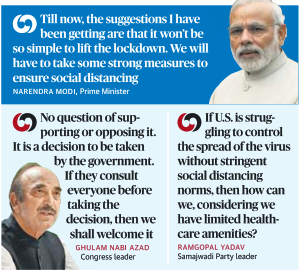
Govt. Caps Spending Amid Cash Crunch
Informations in News:
With the Centre expecting an extreme cash crunch due to the COVID-19 crisis, most Central government departments have been asked to cut their first quarter expenditure to 15-20% of the year’s budget estimates (BE).
several development sector Ministries including those dealing with education, tribal welfare, women and children, social justice and labour have been asked to restrict expenditure to 15% of BE.
“Existing guidelines for expenditure control have been reviewed. Keeping in view the present situation arising out of the COVID-19 and the consequential lockdown, it is expected that the cash position of government may be stressed in Q1 (April to June 2020). Considering this, it is essential to regulate the government expenditure and to fix the Quarterly Expenditure Plan (QEP) / Monthly Expenditure Plan (MEP) of specific Ministries/Departments,” said the circular issued by the Finance Ministry on Wednesday.
“Any deviation from this guideline would require prior approval from Ministry of Finance,” it added. Large expenditures are already subject to the expenditure control guidelines of August 2017 which says prior permission is required for any single payment above ₹5,000 crore.
The economic slowdown had already spurred the Finance Ministry to cap spending in the last quarter of 2019-20 (January-March 2020) to 25% of BE, from the earlier 33%.
The circular lists 17 key demands for grants and appropriations that will not be affected by the restrictions.
- Apart from the key ministries related to health, agriculture and rural affairs, food and essential commodities and transport which were listed above, the Supreme Court and President can continue spending as usual. The Central Vigilance Commission and Union Public Service Commission also fall in this category.
- Another 31 departments have been asked to restrict expenditure to 20% of BE, with 8% allowed in April and 6% each in May and June. This includes the Cabinet, the Houses of Parliament and Police. The Ministries of Home, External Affairs and some departments of Defence and Finance are also included in this category, as are transfers to union territories, including Delhi.
- The largest category of 52 departments have been told to restrict quarterly expenditure to 15% of BE, with 5% allowed each month. This includes Commerce and Industry, Housing and Urban Affairs, School and Higher Education, Social Justice and Empowerment, Tribal Affairs, Fisheries and Animal Husbandry and a slew of others.
Govt. Caps Spending Amid Cash Crunch
Informations in News:
An expert committee headed by former Chief Secretary K.M. Abraham has recommended a phased relaxation of the lockdown to contain COVID-19 for areas outside the seven hotspot districts in the State from April 15.
“It should be borne in mind that the phased withdrawal is sustainable only if there is a steady recovery and decline in the number of cases leading to initial flattening of the infection curve and then gradual tapering of the curve to zero infection cases,” the committee said.
It has asked the government to advise the people that in the event of a resurgence, they should be ready and willing to undergo the rigours of a complete lockdown once again.
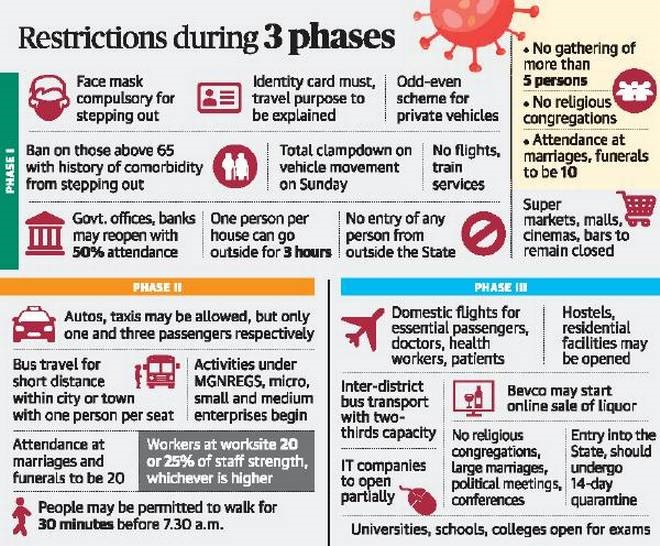
Phase I relaxation
- For qualifying for Phase 1 relaxation, there has to be not more than one new case in the district for the entire week prior to the date of review on April 14.
- No increase more than 10% of the number of persons under home surveillance in the district and no hotspots of COVID-19 anywhere in the district as identified by the Health Department are the other criteria fixed.
Phase II relaxation
- A district will qualify for Phase II relaxation at the time of second review only if there is no more than one new case for the entire fortnight prior to the date of review.
- Not more than a 5% increase in the number of persons under home surveillance from the date of the previous review and no infection hotspots are the additional criteria.
Phase III relaxation
- A district will qualify for Phase III relaxation only if there is no new case of infection in that district for the fortnight prior to the date of review.
- In addition, a decrease of more than 5% of the number of persons under home surveillance in the district from the date of the previous review and no hotspots anywhere in the district are needed.
The committee has also come up with health-related and non-health-related objectives for the withdrawal strategy and steps for management of hotshots and vulnerable population.
Kerala Infant Gets Treatment For Eye Cancer In Hyderabad :
Informations in News:
- The power of social media and the joint effort of Kerala and Telangana governments as well as many other committed healthcare workers and organisations ensured that baby Anvitha got her timely Intra Arterial Chemotherapy treatment for retinoblastoma at the L.V. Prasad Eye Institute here on Wednesday.
- The timely intervention of the government helped Mohammed Nahyan, a twoyearold boy from Mathilakam in Thrissur district suffering from retinoblastoma (eye cancer), to go to a Chennai hospital for emergency treatment. Nahyan, son of Fazil and Abida of Kulimuttam, Mathilakam, has been suffering from retinoblastoma for the past oneandahalf years. He was diagnosed with the disease just four months after his birth.
As a rare disease, there was no treatment for retinoblastoma in Kerala. So his parents approached Sankara Netralaya in Chennai for treatment.
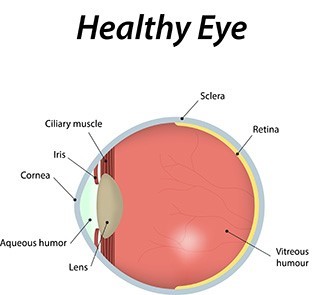
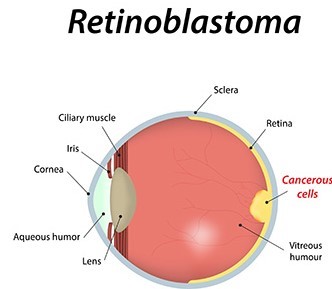
Retinoblastoma
Retinoblastoma is a cancer that starts in the retina, the very back part of the eye. It is the most common type of eye cancer in children.
- The eyes start to develop well before birth. During the early stages of development, the eyes have cells called retinoblasts, which multiply to make new cells that fill the retina. At a certain point, these cells stop multiplying and become mature retinal cells.
- Rarely, something goes wrong with this process. Instead of maturing, some retinoblasts continue to grow out of control, forming a cancer known as retinoblastoma.
- The chain of events inside cells that leads to retinoblastoma is complex, but it almost always starts with a change (mutation) in the RB1
Wildlife Board Holds Virtual Meet
Informations in News:
The Standing Committee of the National Board for Wildlife had its first ever video-conferencing meet on Monday where infrastructure projects in 11 States were cleared, Environment Minister Prakash Javadekar tweeted.
- Two were infrastructure proposals related to setting up power transmissions line and constructing a highway in Goa, which would “boost tourism.”
- Other projects included the Nagpur-Mumbai superhighway, a small-scale stone mining project in Kota, Rajasthan; an underground pumped storage facility for generating hydroelectricity; an Indian railways project to make a railway bridge in Madhya Pradesh and Telangana, irrigation projects in Uttarakhand and Telangana and defence projects in Uttarakhand.
Projects that encroach into forests or protected reserves require NBWL nod as part of the government’s environmental clearance process. Projects are appraised at a State level and then subsequently presented to a large committee of wildlife experts, the Chief Wildlife Wardens of States, top officials in the Union Environment Ministry and Forest Ministry and, the Environment Minister.
National Board for Wildlife
- National Board for Wild Life is a “Statutory Organization” constituted under the Wildlife Protection Act, 1972.
- Theoretically, the board is “advisory” in nature and advises the Central Government on framing policies and measures for conservation of wildlife in the country.
- It is an apex body and has power to review all wildlife-related matters and approve projects in and around national parks and sanctuaries.
- Primary function of the Board is to promote the conservation and development of wildlife and forests.
- No alternation of boundaries in national parks and wildlife sanctuaries can be done without approval of the NBWL.
- The NBWL is chaired by the Prime Minister.
- It has 47 members including the Prime Minister. Among these, 19 members are ex-officio members. Other members include three Members of Parliament (two from Lok Sabha and one from Rajya Sabha), five NGOs and 10 eminent ecologists, conservationists and environmentalists.
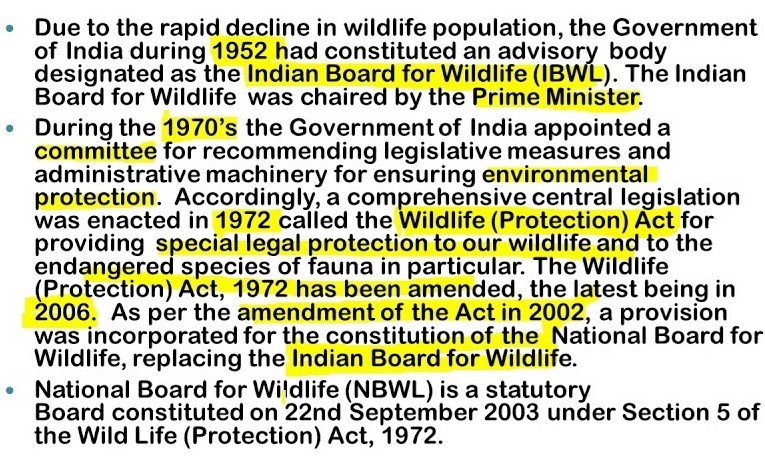
States Told To Curb Black Marketing
Information in News:
Offences under the Act are criminal offences and may result in imprisonment of seven years or fine or both.
Union Home Secretary Ajay Bhalla wrote to all State Chief Secretaries on Wednesday to ensure the availability of essential goods by invoking the provisions of the Essential Commodities (EC) Act 1955.
- Offences under the EC Act are criminal offences and may result in imprisonment of seven years or fine or both. The State and Union Territory governments may also consider detention of offenders under the Prevention of Black-marketing and Maintenance of Supplies of Essential Commodities Act, 1980, Ministry of Home Affairs (MHA) said.
These measures include fixing of stock limits, capping of prices, enhancing production, inspection of accounts of dealers and other such actions
Loss of production
There have been reports of loss of production due to various factors, especially reduction in labour supply. In this situation, there is a possibility of inventory building/hoarding and black marketing, profiteering, and speculative trading, resulting in price rise of essential goods. The States have been asked to take urgent steps to ensure availability of these commodities at fair prices for public at large.
Earlier, with an order issued under the Disaster Management Act, 2005, the MHA had allowed manufacture/production, transport and other related supply-chain activities in respect of essential goods such as foodstuff, medicines and medical equipment.
Further, Ministry of Consumer Affairs, Food & Public Distribution is authorising States and Union Territories to notify orders under the EC Act, 1955 by relaxing the requirement of prior concurrence of the Central government up to June 30, 2020.
Government brings masks and hand sanitizers under the Essential Commodities Act.
Essential Commodities Act, 1955
- The ECA was enacted way back in 1955.
- It has since been used by the Government to regulate the production, supply and distribution of a whole host of commodities it declares ‘essential’ in order to make them available to consumers at fair prices.
- The list of items under the Act includedrugs, fertilisers, pulses and edible oils, and petroleum and petroleum products.
- The Centre can include new commodities as and when the need arises, and take them off the list once the situation improves.
- Under the Act, the government can also fix the maximum retail price (MRP) of any packaged product that it declares an “essential commodity”.
What does the Act deal with?
- The Act empowers the Central and state governments concurrently to control production, supply and distribution of certain commodities in view of rising prices.
- The measures that can be taken under the provision of the Act include, among others, licensing, distribution and imposing stock limits.
- The governments also have the power to fix price limits, and selling the particular commodities above the limit will attract penalties.
- Black marketing of essential commodities was a major problem in the past and this has now been controlled to a large extent.
- The Drug Price Control Order (DPCO) and such other orders have been issued under the powers of the ECA.
The Prevention of Blackmarketing and Maintenance of Supplies of Essential Commodities Act, 1980
- It extends to the whole of India except the State of Jammu and Kashmir.
- It shall be deemed to have come into force on the 5th day of October, 1979.
Disaster Management act 2005
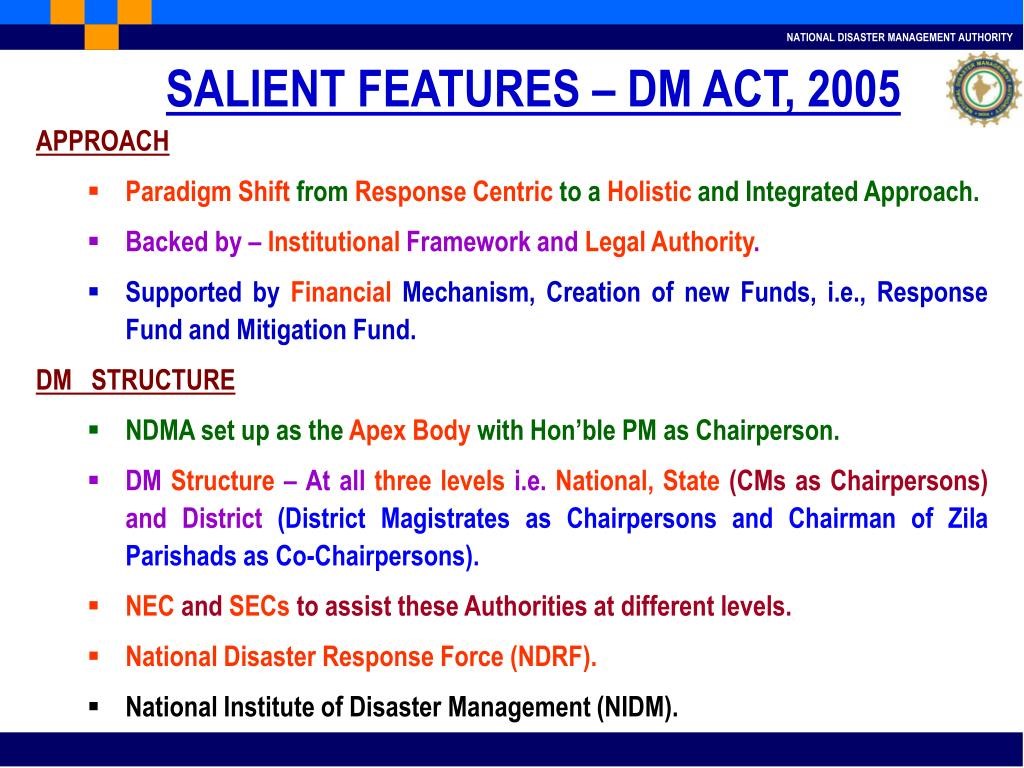
Virus Hits Both Genders Equally, Except In 2 Nations
Information in News
76% of the confirmed cases in India and 72% in Pakistan are men.
In a striking contrast with many countries, men in India more than women appear disproportionately likely to test positive for COVID- 19, an analysis of global data shows.
Many countries — including the United Kingdom and the United States — while publicising data on cases and death rates don’t have sex-segregated national data. However, data from 40 countries, which do share such data and compiled by GlobalHealth5050, an independent research initiative that tracks gender and health, suggest that the gender-split in all countries is roughly 50-50, barring two exceptions: India and Pakistan. 72% of our neighbour’s 4,004 cases have been confirmed in men.
- Another unusual exception was South Korea — the country that has conducted the maximum number of tests as a proportion of population — in that more women tested positive than man. 60% of its 10,000 cases, as on Wednesday, were women.
- Germany, another country that has tested significantly, notes an even split, 50: 50 in its case load of 99,255.
However, men in all countries were significantly more likely — almost twice — to die than women, though this data point is available for only 18 countries. India hasn’t yet shared national figures on COVID-19 mortality rates in men and women.
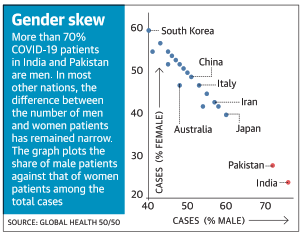
Giridhar Babu, an epidemiologist associated with the Public Health Foundation of India, said it was likely that in most countries international travelers, the key source of the initial tranche of infections in most countries were equally likely to be men or women. “It’s possibly more reflective of employment trends in India. Women are much less likely to be travelling for work internationally from India.”
Global COVID research so far has also shown that men are more likely to be harbouring additional ailments: cardiovascular disease, diabetes and more likely to smoke, making them even more vulnerable to a severe potentially fatal infection.
Poaching, not virus, is the bigger threat, says tiger expert
Information in News
If we fail to stop the killing of prey animals such as deer during the lockdown, big cat populations will suffer, says Ullas Karanth
Wildlife scientist Ullas Karanth, an expert on tiger conservation, has cautioned that a spurt in poaching during the lockdown period poses a greater threat to wildlife than the coronavirus (COVID-19).
The warning came after the advisory issued by the National Tiger Conservation Authority (NTCA) and the Wildlife Division of the Ministry of Environment, Forests and Climate Change for immediate preventive measures to stop the spread of the virus from humans to animals and vice-versa in national parks, sanctuaries and tiger reserves. The advisory came after a tiger at the Bronx zoo in the U.S. tested positive for the novel coronavirus. Dr. Karanth worked for three decades with the organisation that runs the zoo, the Wildlife Conservation Society.
This specific virus was known to affect domestic cats and it came as no surprise that tigers could get it too.
The real threat to tigers was posed by a surge in local poaching of prey species during the lockdown. The police were busy otherwise, and forest officials faced movement constraints, emboldening a new wave of poachers, he said.
The Director of Bandipur Tiger Reserve said there was no known case of poaching in protected areas where fire guards supplemented the field staff
This being fire season, there were 400 fire watchers in Bandipur besides field staff and another 400 watchers in Nagarahole, two famous tiger reserves, and the added staff would deter poachers.
Cauvery Wildlife Sanctuaries had a history of poaching. The ban on domestic meat sale early in the lockdown may have added to poaching. But the meat sale ban had been lifted and protection stepped up.
Wildlife Conservation Society
- Wildlife Conservation Society(WCS) is a Not-for-profit organization New York City-based organization that currently works to conserve more than two million square miles of wild places around the world.
- Founded in 1895 as the New York Zoological Society(NYZS), the organization is led by President and CEO Cristián Samper, former Director of the Smithsonian Institution‘s National Museum of Natural History.
- Its name was changed to the Wildlife Conservation Society in 1993.
Bronx Zoo
- The Bronx Zoois a zoo located within Bronx Park in the Bronx, New York.
- It is one of the largest zoos in the United States by area, and is the largest metropolitan zoo in the United States by area, comprising 265 acres (107 ha) of park lands and naturalistic habitats separated by the Bronx River.
- The zoo is part of an integrated system of four zoos and one aquarium managed by the Wildlife Conservation Society(WCS), and it is accredited by the Association of Zoos and Aquariums (AZA).
National Tiger Conservation Authority (NTCA)
- The National Tiger Conservation Authority (NTCA) is a statutory bodyof the Ministry, with an overarching supervisory/ coordination role, performing functions as provided in the Wildlife (Protection) Act, 1972.
- The NTCA was launched in 2005, following the recommendations of the Tiger Task Force. It was given statutory status by 2006 amendment of Wildlife (Protection) Act, 1972.
- Project Tiger was launched in 1973with 9 tiger reserves for conserving our national animal, the tiger. Currently, the Project Tiger coverage has increased to 50, spread out in 18 tiger range states.
- The tiger reserves are constituted on a core/buffer strategy. The core areas have the legal status of a national park or a sanctuary, whereas the buffer or peripheral areas are a mix of forest and non-forest land, managed as a multiple use area.
- It is an ongoing Centrally Sponsored Scheme of the Ministry of Environment, Forests and Climate Change providing central assistance to the tiger States for tiger conservation in designated tiger reserves.
Rupee falls 70 paise as virus cases spike sharply
Information in News
Crude price increase adds to pressure
The rupee declined 70 paisa against the dollar on Wednesday following a sharp rise in the number of COVID-19 cases in the country, which could prompt the government to delay the lifting of nationwide lockdown.
The rupee, which opened at 75.83 a dollar, as compared to its previous close of 75.64, depreciated further and went close to its all-time low of 76.38, touching the day’s low of 76.36.
Dollar index impact
The rupee ended the day at 76.34 a dollar, down 70 paisa, or 0.92%, than its previous close. The rise in crude prices and strengthening of the dollar index also added pressure on the rupee.
The Reserve Bank of India (RBI) reduced the timing of market hours for call money market, government securities market and currency market. These have been functioning between 10 a.m. and 2 p.m. since April 7. The shortened market hours will continue till April 17. The decision was taken to avoid undue volatility in the markets caused by thin volumes due to the nationwide lockdown.
IRDAI permits insurers to grant three months’ moratorium on term loans
Information in News
Considering the cash flow problems faced by the borrowers and in line with the recent directions of the RBI on moratorium on term loans, insurers are permitted to grant a moratorium of three months towards payment of instalments falling due between March 1 and May 31, IRDAI said.
The rescheduling of payments, including interest, will not qualify as a default for the purpose of reporting of non-performing assets (NPAs).
Concurrent auditors in their reports for the quarter ending June 2020 shall confirm that the insurers had complied with the Board Approved policy in granting moratorium, IRDAI said.
The Insurance Regulatory and Development Authority of India
The Insurance Regulatory and Development Authority of India or the IRDAI is the apex body responsible for regulating and developing the insurance industry in India. It is an autonomous body. It was established by an act of Parliament known as the Insurance Regulatory and Development Authority Act, 1999. Hence, it is a statutory body.
The IRDAI is headquartered in Hyderabad in Telangana. Before 2001, it was headquartered in New Delhi.
To protect the interests of the policyholders, to regulate, promote and ensure orderly growth of the insurance industry and for matters connected therewith or incidental thereto.
The functions of the IRDA are listed
- Its primary purpose is to protect the rights of the policyholders in India.
- It gives the registration certificate to insurance companies in the country.
- It also engages in the renewal, modification, cancellation, etc. of this registration.
- It also creates regulations to protect policyholders’ interests in India.
Tags : current affairs 2020 100, current affairs 2020 jan, current affairs 2020 pdf, current affairs 2020 quiz, current affairs 2020 hindi, current affairs 2020 india, current affairs 2020 today, current affairs 2020 nigeria, current affairs 2020 questions, current affairs 2020 in tamil, current affairs 2020 gk today, current affairs 2020 in english, current affairs 2020 gd topics, current affairs 2020 pdf download, current affairs 2020 in hindi pdf, current affairs 2020 questions and answers, current affairs 2020 january in affairs cloud,TNPSC Current Affairs 2020, current affairs in tamil, best current affairs for tnpsc exams, tnpsc group 4 current affair, tnpsc group 2 current affairs, tnpsc group 2a current affairs, tnpsc group 1 current affairs, tnpsc current affairs 2019

